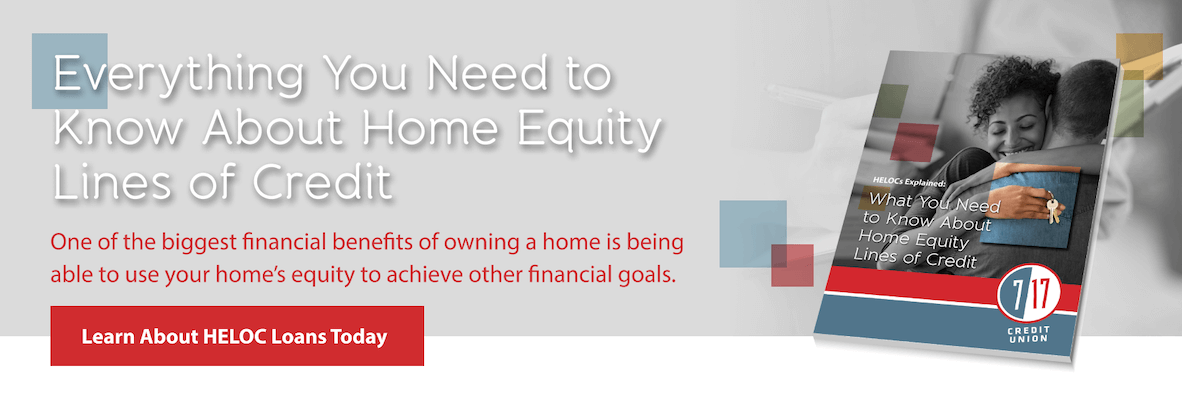- 7 17 Staff
Unveiling Key Differences Between Refinancing, Home Equity Loans, and HELOC

One of the benefits of owning your home is the ability to tap into the equity built up in it in order to achieve your goals. But when you’re looking at refinancing versus a home equity loan versus a HELOC, how do you know the differences between them — or which is best for your situation? Today, we’re digging into the pros and cons of each option so you can make an informed decision that best supports your goals — and your family.
What Is a HELOC?
A home equity line of credit (HELOC) is a revolving credit line based on the equity built up in your home. It works similarly to how a credit card works: You’ll take out the HELOC and once you’ve paid off what you used, the full amount is available to you to use again — all without taking out a new loan.
You’ll also only pay interest on the amount you used. You can use a HELOC however you like, whether by helping to pay for your child’s college tuition, paying for home renovations, paying off high-interest debt or paying for medical expenses.
Pros of HELOCs
You can use a HELOC for whatever you like during the draw period, which is generally around 10 years. During this period you can withdraw funds and then pay off your balance as you wish.
A repayment period follows this draw period, with the repayment period lasting about 20 years depending on your lender. You can choose your repayment terms, including the payment amounts and schedule, to align your repayment with what works best for your budget.
Additionally, you’ll have few (if any) closing costs.
Cons of HELOCs
While HELOCs can be used for whatever you choose, they aren’t recommended for short-term expenses such as large discretionary purchases or vacations. This is because using a HELOC for a vacation usually indicates that you’re spending beyond your means. Using debt to fund a lifestyle purchase can worsen debt problems and repayment.
HELOCs generally have an adjustable interest rate, so your monthly payments may vary. However, it’s important to note that some lenders may allow your HELOC to be converted to a fixed interest rate.
What Is a Home Equity Loan?
A home equity loan is a second mortgage that’s given to you in one lump sum. Unlike HELOCs, you can’t reuse a home equity loan without repaying the debt and then reapplying for a new home equity loan. Additionally, with a home equity loan, you’ll be starting repayment right away.
Pros of Home Equity Loans
You’ll have a fixed interest rate for your loan, so you’ll always know what your payments will be as they won’t vary. This makes it easier to factor home equity loans into your budget.
Cons of Home Equity Loans
Your home equity loan payment is in addition to your mortgage payment. Home equity loans are delivered in one lump sum, which can make them a great source for major projects, but can also work against you if the property values around you decline.
You’ll also have many of the same closing costs as you did for your first mortgage loan. For example, you’ll have appraisal fees, recording fees, loan origination fees and loan processing fees.
What Does it Mean to Refinance a Loan?
Refinancing revises and replaces the terms of your existing loan or mortgage. Refinancing is beneficial when interest rates change, which can result in significant savings on debt payments with a new loan agreement.
This option is different from a HELOC and home equity loan because you’re not receiving money to complete projects or cover long-term expenses. Instead, you’re adjusting your repayment terms so they’re more favorable to you, whether by lowering your interest rate to reduce payments over the life of your loan, switching from an adjustable rate to a fixed rate or aiming to pay off your debt sooner.
Pros of Refinancing
There are several options available to you. For example, you can simply change the rate and term of your loan with rate and term refinancing.
Alternatively, you can explore cash-out refinancing to withdraw the value of your home in exchange for an increased loan amount. Lastly, you may find cash-in refinancing beneficial for your situation. With this option, you’ll pay down some of your loan for smaller loan payments.
One of the top benefits of refinancing is the potential to get a lower monthly payment, interest rate or shorter loan term.
Cons of Refinancing
If interest rates decrease and you’ve switched from an adjustable rate to a fixed rate, you won’t experience the benefit of reduced payments.
If you choose a shorter loan term, your monthly payments will increase, so it’s important to be prepared for this by ensuring you have room in your budget for the increased expense.
Tap Into Your Home’s Equity and Unlock Its Potential
Now that you know a bit about your options, it’s time to explore more in-depth to find the right product for your goals. Get started today with our guide, “HELOCs Explained: What You Need to Know About Home Equity Lines of Credit”.
